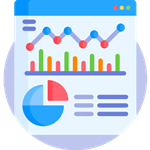 Welcome to Thesis-Dissertation Writing Services, where we are dedicated to connecting you with top-tier project data consultants. When it comes to harnessing the power of data for insightful decision-making, our team stands at the forefront of excellence. In this era of information overload, navigating through vast datasets and extracting meaningful conclusions requires a specialized skill set. That's where our data analysis experts shine. Our experts have unparalleled expertise, having honed through years of dedicated practice and academic rigor. Our professionals are not only well-versed in the technical intricacies of data analysis, but they also possess an intuitive understanding of research methodologies, data interpretation, and the art of transforming raw data into actionable insights. Our experts are equipped with a deep understanding of various industries and research domains, enabling them to approach each project with a tailored perspective. Whether you're a researcher, a business professional, or an academician, our data consultants are adept at customizing their analytical approach to suit your specific needs. In addition to their technical prowess, our data experts are exceptional communicators. They can translate complex statistical findings into comprehensible insights, empowering you to make informed decisions with confidence. With a proven track record of successful projects, our professionals are committed to not just delivering results, but driving real-world impact through data-driven strategies. When you choose our platform, you're not just hiring a data consultant; you're partnering with a visionary who can illuminate the hidden stories within your data. Experience the transformative power of expert data analysis, because making sense of data is no longer a luxury, but a necessity.
Welcome to Thesis-Dissertation Writing Services, where we are dedicated to connecting you with top-tier project data consultants. When it comes to harnessing the power of data for insightful decision-making, our team stands at the forefront of excellence. In this era of information overload, navigating through vast datasets and extracting meaningful conclusions requires a specialized skill set. That's where our data analysis experts shine. Our experts have unparalleled expertise, having honed through years of dedicated practice and academic rigor. Our professionals are not only well-versed in the technical intricacies of data analysis, but they also possess an intuitive understanding of research methodologies, data interpretation, and the art of transforming raw data into actionable insights. Our experts are equipped with a deep understanding of various industries and research domains, enabling them to approach each project with a tailored perspective. Whether you're a researcher, a business professional, or an academician, our data consultants are adept at customizing their analytical approach to suit your specific needs. In addition to their technical prowess, our data experts are exceptional communicators. They can translate complex statistical findings into comprehensible insights, empowering you to make informed decisions with confidence. With a proven track record of successful projects, our professionals are committed to not just delivering results, but driving real-world impact through data-driven strategies. When you choose our platform, you're not just hiring a data consultant; you're partnering with a visionary who can illuminate the hidden stories within your data. Experience the transformative power of expert data analysis, because making sense of data is no longer a luxury, but a necessity.
Why you Should Hire our Data Experts to Analyze your Project Data;
Our experts are proficient in navigating the intricacies of the software, enabling them to execute complex statistical analyses and interpret results accurately. Hiring our experts ensures that data is cleaned, organized, and properly formatted for analysis, thereby enhancing the credibility of the findings. More so, our research project data analysis experts for hire possess the ability to interpret statistical outputs in the context of the research project's goals, providing valuable insights that guide decision-making. Relevantly, each research project is unique, and our experts can tailor their analyses to fit the specific research questions, ensuring the most relevant and applicable results.
Do Consultants use Data Analytics? Qualified Data Analysts
Data consultants play a crucial role in modern business and research landscapes. They leverage data analytics to extract meaningful insights from large and complex datasets, helping organizations make informed decisions. Data analytics provide several benefits:
- Evidence-Based Decisions: Data-driven insights offer a factual basis for decision-making, minimizing subjective biases and guesswork.
- Identifying Patterns: Data analytics helps consultants identify trends, patterns, and correlations that might not be apparent through casual observation.
- Performance Evaluation: Consultants use analytics to assess the performance of strategies, products, or processes, enabling companies to refine and optimize their operations.
- Predictive Analysis: By analyzing historical data, consultants can create models to predict future trends and outcomes, enabling proactive planning.
Is There a Difference Between a Data Analyst and a Data Consultant?
While the terms "data analyst" and "data consultant" are often used interchangeably, they encompass distinct roles. Data analysts focus on collecting, processing, and interpreting data to support operational decision-making within an organization. Their primary goal is to uncover insights and trends from data. Data consultants, on the other hand, provide strategic guidance to organizations on how to leverage data to achieve their goals. They not only analyze data but also offer recommendations, develop data strategies, and assist in implementing data-driven changes.
The Limitations af Analyzing Research Project Data Without Experts’ Help
Attempting to analyze research project data without the assistance of data experts can lead to several limitations:
- Improper use of statistical techniques can yield inaccurate results, potentially invalidating the research findings.
- Without expert guidance, the interpretation of statistical outputs can be flawed, leading to incorrect conclusions being drawn.
- Inefficient analysis can waste valuable time and resources, as researchers may need to redo the analysis or even the entire study.
- Inadequate data analysis might result in missed opportunities to uncover meaningful insights that could inform future research directions.
The significance of project data analysis cannot be overstated. Hiring SPSS experts ensures meticulous analysis, reliable interpretation, and actionable insights that drive decision-making. Data consultants, equipped with the prowess of data analytics, empower organizations to harness the potential of their data effectively. While data analysts and data consultants share similarities, the latter offers a broader strategic perspective. The perils of overlooking expert assistance in data analysis underscore the necessity of investing in skilled professionals to unlock the full potential of research endeavors.
Data Analysis Specialists for Research Projects | Data Visualization
 In the realm of modern research, where data drives insights and decisions, the role of professional research project data analysts has become pivotal. As research projects continue to expand in complexity and magnitude, the need for experts who can navigate, interpret, and present data effectively has grown exponentially. This is where our proficient team of specialists excels. We take pride in being at the forefront of data-driven research solutions. Our specialists possess a unique blend of technical prowess and analytical acumen, making them an indispensable asset for any research endeavor. What sets our specialists apart is not only their mastery of cutting-edge tools and techniques but also their unwavering commitment to turning raw data into actionable knowledge. One of the hallmarks that makes our data visualization experts preferable is their unrivaled skill in data visualization. While data analysis unearths patterns and correlations, it's the art of visualization that breathes life into these insights, making them understandable and compelling to both experts and non-experts alike. Our specialists craft visually stunning representations that transcend the limitations of numbers, enabling stakeholders to grasp the significance of the data at a glance. Furthermore, our specialists understand that every research project is unique, demanding tailored approaches. Their adaptability, coupled with their profound domain knowledge, empowers them to unravel intricate research challenges efficiently. By choosing our specialists, you're not just selecting experts – you're opting for partners who are dedicated to transforming your data into a captivating narrative, driving your research project toward impactful outcomes.
In the realm of modern research, where data drives insights and decisions, the role of professional research project data analysts has become pivotal. As research projects continue to expand in complexity and magnitude, the need for experts who can navigate, interpret, and present data effectively has grown exponentially. This is where our proficient team of specialists excels. We take pride in being at the forefront of data-driven research solutions. Our specialists possess a unique blend of technical prowess and analytical acumen, making them an indispensable asset for any research endeavor. What sets our specialists apart is not only their mastery of cutting-edge tools and techniques but also their unwavering commitment to turning raw data into actionable knowledge. One of the hallmarks that makes our data visualization experts preferable is their unrivaled skill in data visualization. While data analysis unearths patterns and correlations, it's the art of visualization that breathes life into these insights, making them understandable and compelling to both experts and non-experts alike. Our specialists craft visually stunning representations that transcend the limitations of numbers, enabling stakeholders to grasp the significance of the data at a glance. Furthermore, our specialists understand that every research project is unique, demanding tailored approaches. Their adaptability, coupled with their profound domain knowledge, empowers them to unravel intricate research challenges efficiently. By choosing our specialists, you're not just selecting experts – you're opting for partners who are dedicated to transforming your data into a captivating narrative, driving your research project toward impactful outcomes.
The role of data analysts in enhancing projects through data visualization
In the age of information overload, the ability to present complex research findings in an easily digestible format is crucial. This is where data analysis specialists for research projects intervene. They act as interpreters of data, bridging the gap between raw numbers and actionable insights. Their role extends beyond merely plotting graphs; they craft visualizations that encapsulate the essence of the data, making it accessible and engaging for various stakeholders. Specialists possess a deep understanding of statistical methods, programming languages, and data manipulation tools. They are equipped to handle diverse datasets and are skilled in identifying patterns, correlations, and outliers that might otherwise go unnoticed. By harnessing their expertise, research projects can derive more accurate conclusions and make informed decisions.
How to transform complex research data into clear visual stories
Converting intricate research data into clear visual stories is an art that data analysis experts have mastered. The process involves several key steps:
- Data Cleaning and Preparation: Data often come with imperfections. Specialists clean and organize the data, ensuring accuracy and consistency.
- Choosing Appropriate Visualizations: Different datasets require different visualization techniques. Specialists select the most suitable charts, graphs, maps, or diagrams to effectively convey the intended message.
- Creating Compelling Visuals: Beyond generic visualizations, specialists craft visuals that are visually appealing and convey insights seamlessly. They use color, size, and layout strategically to highlight key points.
- Telling a Story: Data visualization isn't just about numbers; it's about telling a story. Specialists structure the visuals in a narrative that guides the audience through the data, making the information more relatable and engaging.
- Iterative Refinement: Specialists iterate and refine their visualizations based on feedback and new insights, ensuring the final product is polished and impactful.
Weave insights from data with the help of our data experts
Data analysts serve as the weavers of insights, extracting valuable knowledge from the labyrinth of data. Their contribution extends beyond creating visuals; they interpret the trends, draw connections, and unearth hidden gems that drive innovation and informed decision-making. By collaborating with these specialists, research projects can gain a competitive edge and maximize the value of their data-driven efforts. These specialists bring domain expertise, statistical rigor, and creativity to the table. They are adept at identifying actionable insights that can guide strategic directions, optimize processes, and predict future trends. Their involvement in research projects ensures that data is not just a collection of numbers but a powerful tool for generating transformative ideas.
Data experts play a pivotal role in research projects by transforming intricate data into compelling visual stories. Their expertise bridges the gap between data and insights, enabling stakeholders to make informed decisions. Through their mastery of visualization techniques, data specialists weave a tapestry of knowledge that guides research endeavors toward success. Embracing their skills is essential for any project that seeks to unlock the true potential of its data.




 In the ever-evolving landscape of research and academia, the paramount significance of accurate and insightful data analysis cannot be overstated. As researchers delve into the depths of their projects, the intricate web of information they gather holds the key to unlocking new insights and shaping groundbreaking conclusions. This is where our
In the ever-evolving landscape of research and academia, the paramount significance of accurate and insightful data analysis cannot be overstated. As researchers delve into the depths of their projects, the intricate web of information they gather holds the key to unlocking new insights and shaping groundbreaking conclusions. This is where our  We guarantee you the
We guarantee you the 